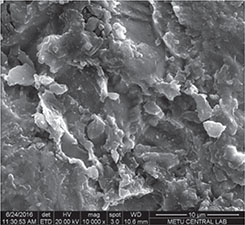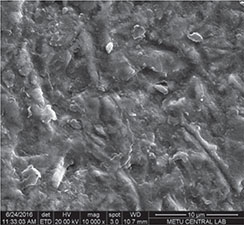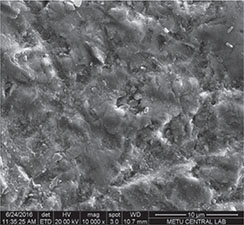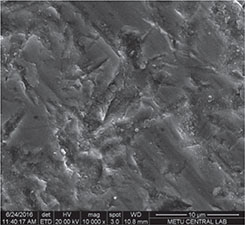J Adv Prosthodont.
2018 Jun;10(3):205-210. 10.4047/jap.2018.10.3.205.
In vitro shear bond strength between fluorinated zirconia ceramic and resin cements
- Affiliations
-
- 1Department of Prosthodontics, Faculty of Dentistry, Gazi University, Ankara, Turkey. mervec_@hotmail.com
- 2Department of Prosthodontics, Faculty of Dentistry, Osmangazi University, EskiÅŸehir, Turkey.
- 3Department of Prosthodontics, Faculty of Dentistry, Gazi University, Ankara, Turkey.
- 4Department of Chemistry, Polymer Chemistry Division, Hacettepe University, Beytepe, Ankara, Turkey.
- 5Department of Chemistry, Hacettepe University, Beytepe, Ankara, Turkey.
- 6Faculty of Dentistry, Osmangazi University, EskiÅŸehir, Turkey.
- KMID: 2413489
- DOI: http://doi.org/10.4047/jap.2018.10.3.205
Abstract
- PURPOSE
The purpose of this study was to evaluate the efficiency of a gas-phase fluorination method under different fluorination periods through using two resin cements.
MATERIALS AND METHODS
84 zirconia specimens in dimensions of 5 mm × 5 mm × 2 mm were prepared and surface treated with 50 µm aluminum oxide particles or gas phase fluorination for 2 min, 5 min, or 10 min. One specimen in each group was surface analyzed under scanning electron microscope. The remaining specimens were bonded to composite cylinders in dimensions of 2 mm diameter and 3 mm high with Panavia SA Plus or Variolink N. Then, the specimens were stored in 37℃ distilled water for 24 hours and shear bond strength test was applied at a speed of 1 mm/min.
RESULTS
The highest shear bond strength values were observed in the samples fluorinated for 5 minutes and cemented with Panavia SA Plus. Variolink N did not elicit any statistical differences between surface treatments. Panavia SA Plus resin cement and Variolink N resin cements featured statistically significant difference in shear bond strength values only in the case of 5 minutes of fluorination treatment.
CONCLUSION
According to the results of this study, application of 5 minutes of fluorination with 10-methacryloyloxydecyl dihydrogen phosphate monomer (MDP) containing Panavia SA Plus resin cement increased the resin bond strength of zirconia. Fluorination of the zirconia surface using conventional resin cement, Variolink N, did not lead to an increase in bond strength.
Keyword
MeSH Terms
Figure
Reference
-
1. Han GJ, Kim JH, Cho BH, Oh KH, Jeong JJ. Promotion of resin bonding to dental zirconia ceramic using plasma deposition of tetramethylsilane and benzene. Eur J Oral Sci. 2017; 125:81–87.
Article2. Martins AR, Gotti VB, Shimano MM, Borges GA, Gonçalves Lde S. Improving adhesion between luting cement and zirconia-based ceramic with an alternative surface treatment. Braz Oral Res. 2015; 29:54.
Article3. Ahrari F, Boruziniat A, Alirezaei M. Surface treatment with a fractional CO2 laser enhances shear bond strength of resin cement to zirconia. Laser Ther. 2016; 25:19–26.
Article4. Rona N, Yenisey M, Kucukturk G, Gurun H, Cogun C, Esen Z. Effect of electrical discharge machining on dental Y-TZP ceramic-resin bonding. J Prosthodont Res. 2017; 61:158–167.
Article5. Vicente M, Gomes AL, Montero J, Rosel E, Seoane V, Albaladejo A. Influence of cyclic loading on the adhesive effectiveness of resin-zirconia interface after femtosecond laser irradiation and conventional surface treatments. Lasers Surg Med. 2016; 48:36–44.
Article6. Yenisey M, Dede DÖ, Rona N. Effect of surface treatments on the bond strength between resin cement and differently sintered zirconium-oxide ceramics. J Prosthodont Res. 2016; 60:36–46.
Article7. Hallmann L, Ulmer P, Lehmann F, Wille S, Polonskyi O, Johannes M, Köbel S, Trottenberg T, Bornholdt S, Haase F, Kersten H, Kern M. Effect of surface modifications on the bond strength of zirconia ceramic with resin cement resin. Dent Mater. 2016; 32:631–639.
Article8. El Gamal A, Medioni E, Rocca JP, Fornaini C, Muhammad OH, Brulat-Bouchard N. Shear bond, wettability and AFM evaluations on CO2 laser-irradiated CAD/CAM ceramic surfaces. Lasers Med Sci. 2017; 32:779–785.
Article9. Kasraei S, Atefat M, Beheshti M, Safavi N, Mojtahedi M, Rezaei-Soufi L. Effect of surface treatment with carbon dioxide (CO2) laser on bond strength between cement resin and zirconia. J Lasers Med Sci. 2014; 5:115–120.10. Şanlı S, Çömlekoğlu MD, Çömlekoğlu E, Sonugelen M, Pamir T, Darvell BW. Influence of surface treatment on the resinbonding of zirconia. Dent Mater. 2015; 31:657–668.
Article11. Unal SM, Nigiz R, Polat ZS, Usumez A. Effect of ultrashort pulsed laser on bond strength of Y-TZP zirconia ceramic to tooth surfaces. Dent Mater J. 2015; 34:351–357.
Article12. Anand S, Ebenezar AV, Anand N, Rajkumar K, Mahalaxmi S, Srinivasan N. Microshear bond strength evaluation of surface pretreated zirconia ceramics bonded to dentin. Eur J Dent. 2015; 9:224–227.
Article13. Ishii R, Tsujimoto A, Takamizawa T, Tsubota K, Suzuki T, Shimamura Y, Miyazaki M. Influence of surface treatment of contaminated zirconia on surface free energy and resin cement bonding. Dent Mater J. 2015; 34:91–97.
Article14. Thompson JY, Stoner BR, Piascik JR, Smith R. Adhesion/cementation to zirconia and other non-silicate ceramics: where are we now? Dent Mater. 2011; 27:71–82.
Article15. Luthra R, Kaur P. An insight into current concepts and techniques in resin bonding to high strength ceramics. Aust Dent J. 2016; 61:163–173.
Article16. Yavuz T, Özyılmaz ÖY, Dilber E, Tobi ES, Kiliç HŞ. Effect of different surface treatments on porcelain-resin bond strength. J Prosthodont. 2017; 26:446–454.
Article17. Vechiato-Filho AJ, Matos AO, Landers R, Goiato MC, Rangel EC, De Souza GM, Barão VAR, Dos Santos DM. Surface analysis and shear bond strength of zirconia on resin cements after non-thermal plasma treatment and/or primer application for metallic alloys. Mater Sci Eng C Mater Biol Appl. 2017; 72:284–292.
Article18. Piascik JR, Swift EJ, Thompson JY, Grego S, Stoner BR. Surface modification for enhanced silanation of zirconia ceramics. Dent Mater. 2009; 25:1116–1121.
Article19. Pharr SW, Teixeira EC, Verrett R, Piascik JR. Influence of veneering fabrication techniques and gas-phase fluorination on bond strength between zirconia and veneering ceramics. J Prosthodont. 2016; 25:478–484.
Article20. Piascik JR, Wolter SD, Stoner BR. Enhanced bonding between YSZ surfaces using a gas-phase fluorination pretreatment. J Biomed Mater Res B Appl Biomater. 2011; 98:114–119.
Article21. Piascik JR, Swift EJ, Braswell K, Stoner BR. Surface fluorination of zirconia: adhesive bond strength comparison to commercial primers. Dent Mater. 2012; 28:604–608.
Article22. Otani A, Amaral M, May LG, Cesar PF, Valandro LF. A critical evaluation of bond strength tests for the assessment of bonding to Y-TZP. Dent Mater. 2015; 31:648–656.
Article23. Murthy V, Manoharan , Balaji , Livingstone D. Effect of four surface treatment methods on the shear bond strength of resin cement to zirconia ceramics- a comparative in vitro study. J Clin Diagn Res. 2014; 8:ZC65–ZC68.
Article24. Mahmoodi N, Hooshmand T, Heidari S, Khoshro K. Effect of sandblasting, silica coating, and laser treatment on the microtensile bond strength of a dental zirconia ceramic to resin cements. Lasers Med Sci. 2016; 31:205–211.
Article25. Li R, Zhou H, Wei W, Wang C, Sun YC, Gao P. Effects of mechanical and chemical pretreatments of zirconia or fiber posts on resin cement bonding. PLoS One. 2015; 10:e0129690.
Article26. Ito Y, Okawa T, Fukumoto T, Tsurumi A, Tatsuta M, Fujii T, Tanaka J, Tanaka M. Influence of atmospheric pressure lowtemperature plasma treatment on the shear bond strength between zirconia and resin cement. J Prosthodont Res. 2016; 60:289–293.
Article27. Passos SP, Linke B, Major PW, Nychka JA. The effect of airabrasion and heat treatment on the fracture behavior of Y-TZP. Dent Mater. 2015; 31:1011–1021.
Article28. Bagheri H, Hooshmand T, Aghajani F. Effect of ceramic surface treatments after machine grinding on the biaxial flexural strength of different CAD/CAM dental ceramics. J Dent (Tehran). 2015; 12:621–629.29. Aurélio IL, Marchionatti AM, Montagner AF, May LG, Soares FZ. Does air particle abrasion affect the flexural strength and phase transformation of Y-TZP? A systematic review and meta-analysis. Dent Mater. 2016; 32:827–845.
Article30. Wolter SD, Piascik JR, Stoner BR. Characterization of plasma fluorinated zirconia for dental applications by X-ray photoelectron spectroscopy. Appl Surf Sci. 2011; 257:10177–10182.
Article31. Shin YJ, Shin Y, Yi YA, Kim J, Lee IB, Cho BH, Son HH, Seo DG. Evaluation of the shear bond strength of resin cement to Y-TZP ceramic after different surface treatments. Scanning. 2014; 36:479–486.
Article32. Arai M, Takagaki T, Takahashi A, Tagami J. The role of functional phosphoric acid ester monomers in the surface treatment of yttria-stabilized tetragonal zirconia polycrystals. Dent Mater J. 2017; 36:190–194.
Article33. Menani LR, Farhat IA, Tiossi R, Ribeiro RF, Guastaldi AC. Effect of surface treatment on the bond strength between yttria partially stabilized zirconia ceramics and resin cement. J Prosthet Dent. 2014; 112:357–364.
Article34. Xie H, Li Q, Zhang F, Lu Y, Tay FR, Qian M, Chen C. Comparison of resin bonding improvements to zirconia between one-bottle universal adhesives and tribochemical silica coating, which is better? Dent Mater. 2016; 32:403–411.
Article35. de Souza G, Hennig D, Aggarwal A, Tam LE. The use of MDP-based materials for bonding to zirconia. J Prosthet Dent. 2014; 112:895–902.
Article36. Ahn JS, Yi YA, Lee Y, Seo DG. Shear bond strength of MDP-containing self-adhesive resin cement and Y-TZP ceramics: Effect of phosphate monomer-containing primers. Biomed Res Int. 2015; 2015:389234.
Article37. Al-Harbi FA, Ayad NM, Khan ZA, Mahrous AA, Morgano SM. In vitro shear bond strength of Y-TZP ceramics to different core materials with the use of three primer/resin cement systems. J Prosthet Dent. 2016; 115:84–89.
- Full Text Links
- Actions
-
Cited
- CITED
-
- Close
- Share
- Similar articles
-
- Effect of surface treatments of zirconia ceramic on the bond strength of resin cements
- Effect of surface treatment methods on the shear bond strength of resin cement to zirconia ceramic
- The effect of surface treatment conditioning on shear bond strength between zirconia and dental resin cements
- Effect Of Dentin Desensitizers On Shear Bond Strength Of Resin Cements
- Evaluation of shear-bond strength between different self-adhesive resin cements with phosphate monomer and zirconia ceramic before and after thermocycling





